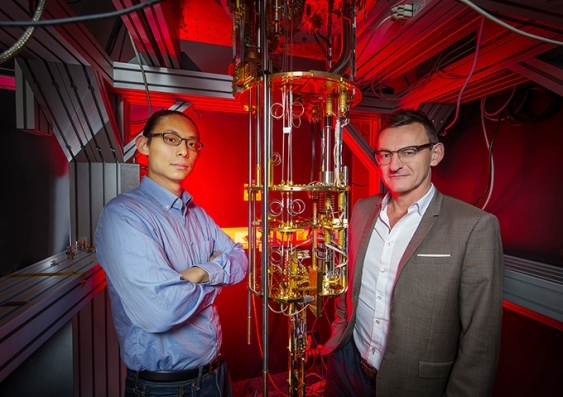Apr 16 2020
A majority of the quantum computers that are currently being developed worldwide will only operate at fractions of a degree above absolute zero. That calls for multi-million-dollar refrigeration, and when individuals plug these computers into traditional electronic circuits, they will begin to overheat immediately.
 Dr Henry Yang and Professor Andrew Dzurak with a dilution refrigerator designed to keep qubits operating at extremely cold temperatures. Image Credit: UNSW Sydney.
Dr Henry Yang and Professor Andrew Dzurak with a dilution refrigerator designed to keep qubits operating at extremely cold temperatures. Image Credit: UNSW Sydney.
This problem has been addressed by scientists, headed by Professor Andrew Dzurak from UNSW Sydney.
Our new results open a path from experimental devices to affordable quantum computers for real world business and government applications.
Andrew Dzurak, Professor, School of Electrical Engineering and Telecommunications, UNSW Sydney
The scientists’ proof-of-concept quantum processor unit cell, embedded on a silicon chip, functions at 1.5 K—that is, 15 times warmer than that of the major competing chip-based technology that utilizes superconducting qubits and is being developed by IBM, Google, and others.
This is still very cold, but is a temperature that can be achieved using just a few thousand dollars’ worth of refrigeration, rather than the millions of dollars needed to cool chips to 0.1 Kelvin. While difficult to appreciate using our everyday concepts of temperature, this increase is extreme in the quantum world.
Andrew Dzurak, Professor, School of Electrical Engineering and Telecommunications, UNSW Sydney
It is believed that quantum computers will supersede the traditional ones for a wide range of significant problems, right from search algorithms to precision drug-making. However, it is a major technical challenge to design a quantum computer that can be produced and operated in a real-world environment.
According to the scientists from UNSW Sydney, they may have resolved one of the most difficult obstacles that are preventing the quantum computers from becoming a reality.
In a study recently published in the Nature journal, Dzurak’s research team, along with colleagues in Japan, Finland, and Canada, has reported a new proof-of-concept quantum processor unit cell that is different from a majority of the designs being studied around the world—that is, this unit cell does not need to work at less than one-tenth of 1 K temperatures.
Dzurak’s research team had initially reported its experimental outcomes through an academic pre-print archive in February 2019. Later in October 2019, the Netherlands-based team, headed by Menno Veldhorst who was a post-doctoral scientist in Dzurak’s group, reported an analogous result by applying the same kind of silicon technology created at UNSW earlier in 2014.
This “hot qubit” behavior confirmed by two groups on opposite sides of the globe resulted in “back-to-back” publication of the two studies in the same issue of the Nature journal.
Qubit pairs can be described as the integral units of quantum computing. Similar to its traditional computing analog—the bit—each qubit defines two states, either 0 or 1, to generate a binary code. But unlike the bit, the qubit can manifest the two states at the same time, in the so-called “superposition.”
Cheaper and Easier to Integrate
Created by Dzurak’s research team, the quantum processor unit cell contains a pair of qubits that are confined in two quantum dots integrated into silicon. The unit cells can be scaled up and generated using prevalent silicon chip factories, which would work without the requirement for multi-million-dollar cooling.
Additionally, it would be relatively easier to incorporate with traditional silicon chips, which will be required to manage the quantum processor. For instance, a quantum computer that is capable of carrying out the intricate calculations required to develop innovative medicines might need millions of qubit pairs, and is typically accepted to be at least 10 years away. This requirement for an unlimited number of qubits poses a major technical challenge to designers.
Every qubit pair added to the system increases the total heat generated, and added heat leads to errors. That’s primarily why current designs need to be kept so close to absolute zero.
Andrew Dzurak, Professor, School of Electrical Engineering and Telecommunications, UNSW Sydney
It is a costly and daunting prospect to maintain quantum computers that have enough number of qubits to be used at temperatures that are relatively colder than deep space, which drives refrigeration technology to the limit.
But the UNSW research team has come up with a sophisticated solution to overcome this issue by initializing and “reading” the pairs of qubit using electrons that tunnel between the pair of quantum dots.
Dr Henry Yang from the UNSW group, who is described as a “brilliant experimentalist” by Dzurak, conducted the proof-of-principle experiments.
Team Effort
Other authors of the study are Ross Leon, Jason Hwang (currently at the University of Sydney), Andre Saraiva, Tuomo Tanttu, Wister Huang, Kok-Wai Chan, and Fay Hudson, all from Professor Dzurak’s group, and also long-time collaborators Dr Arne Laucht and Professor Andrea Morello from UNSW Sydney.
While Dr Kuan-Yen from Finland-based Aalto University helped the device fabrication group, Professor Kohei Itoh from Japan-based Keio University, supplied the enriched silicon-28 wafers from which the devices were produced.
The qubit devices integrated nanometer-scale magnets to facilitate the qubit operation, and these devices were developed with help of a research team headed by Professor Michel Pioro-Ladrière at Université de Sherbrooke in Canada, which also included his PhD student Julien Camirand Lemyre.
Hot Qubits: major quantum computing constraints overcome
Hot Qubits: major quantum computing constraints overcome. Video Credit: UNSW Sydney.